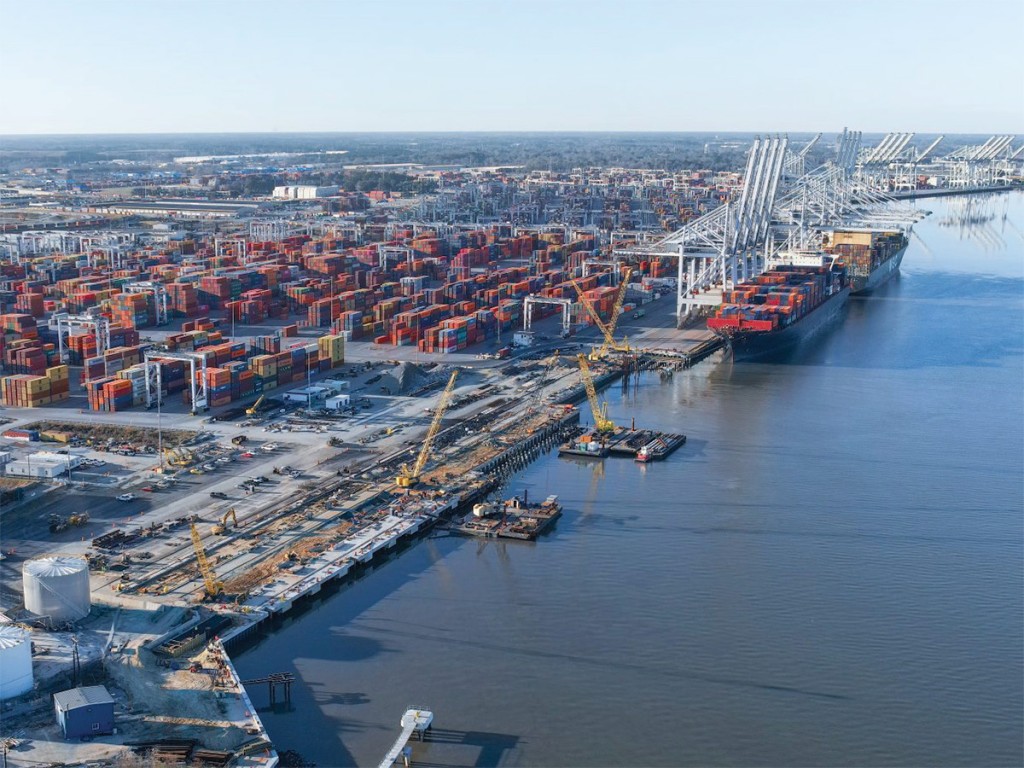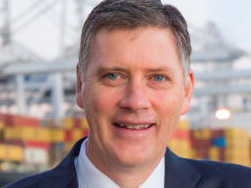Cargo operations are also being rationalized, with Savannah to specialize in handling containers while breakbulk and ro/ro will head to Brunswick. Retaining West Coast diverted freight a priority.

On February 9, the first four of eight new cranes slated to work Berth 1 of the Port of Savannah’s Garden City Terminal arrived at the port, part of a project that will allow Garden City to service larger vessels. When the Berth 1 improvements, which are to add 1.5 million TEU of capacity, are finished in July, the port will be able to simultaneously accommodate four ships of 16,000 TEU or larger, as well as three more ships.
According to the Georgia Ports Authority (GPA) facilities handled a record 5.9 million TEU in 2022, a 5% increase over 2021. In January 2023, Savannah saw total cargo volumes dip 11.5% year over year, including a 16% drop in imports. But January came in 11.7% ahead of the pre-pandemic January 2020 and February is expected to show similar results. Meanwhile, container exports from the Port of Savannah grew a solid 21% in January.

Market Normalizing
“The market is definitely normalizing,” said Griff Lynch, GPA’s executive director. “After a few months of declines, we should start seeing the numbers stabilize and get back to normal. The last two years have not been normal—they’ve been ridiculous.”
Export growth has been driven by increases in furniture, refrigerated goods, and plastics. “The increase in plastics is new business for the port,” noted Lynch, driven by “LNG production in the gulf.”
The Port of Savannah was one of the main beneficiaries of the movement of cargo from West Coast to East Coast ports, as COVID-related supply-chain problems left California ports snarled and the failure to reach a contract with port labor left the threat of a strike looming in the West. But the cargo growth in Savannah is hardly new. The expanded Panama Canal provided shippers with more East Coast options for Asian cargo, and a southward shift of production in Asia saw more cargo arriving in Georgia ports through the Suez Canal. These longer-term cargo growth trends are driving the investments that will increase container capacity at the Port of Savannah from the current 6 million TEU to 9 million by 2025.
“…we should start seeing the numbers stabilize and get back to normal. The last two years have not been normal—they’ve been ridiculous.” - Griff Lynch, Georgia Ports Authority executive director
Besides the improvements being made at the Garden City Terminal, the GPA in January decided to renovate Savannah’s Ocean Terminal, transforming it from a multi-use facility to a container terminal. The ro/ro and breakbulk cargo that is now handled at Ocean Terminal will be directed to the Port of Brunswick, where harbor improvements and an expansion at the Colonel’s Island Terminal are underway.
“Because of the demand on our facilities, we have decided to convert Ocean Terminal to containers,” said Lynch. “Completion of this project will improve our flexibility and allow Georgia ports to optimize cargo movement.” The ro/ro carrier Wallenius Wilhelmsen, the largest customer in Ocean Terminal, will be headed to Brunswick.
But some of Savannah’s breakbulk customers “may have to find another home,” Lynch added. Coiled steel and rubber are two commodities that may end up in other ports.
Ocean Terminal Rebuild
The 200-acre Ocean Terminal facility will be modified in two phases. Rebuilding the docks will provide 2,800 linear feet of berth space, capable of serving two large ships simultaneously with new ship-to-shore cranes. The project will also bring expanded gate facilities to allow for 1.5 million TEU of annual capacity.
Adjacent to the Port of Savannah’s main container terminal, the Garden City Terminal West project will deliver another 90 acres of new storage, supported by 15 electric rubber-tired gantry cranes. “Garden City Terminal West will store up to 20,000 containers,” said Lynch, “and it’s going to have fully electric cranes.” The $200 million project “is well on the way,” he added, with a first phase opening in August and more coming online through January 2024.
“One thing we’ve learned in recent years is, not only have there been berth challenges, but customers need a place to put their cargo when there’s a backlog,” said Lynch. “That’s why our team decided to make this investment.”
At the Port of Brunswick, an additional 360,000 square feet of dockside warehousing, three additional buildings, and 85 acres of storage space will grow annual capacity in Brunswick from 1.2 million to 1.4 million units of ro/ro cargo. “We’re investing over $200 million in enhancing the capabilities for high and heavy cargo, ro/ro, and other breakbulk-type products that will be handled through Brunswick, and we’re going to build another ro/ro berth,” said Lynch. “That project could start as early as this summer and be ready to go in 2025.”
Autos and heavy machinery cargo grew 9% in January, up 4,600 units to 57,127. For the fiscal year to date, Brunswick is up 16.7% to over 411,000 ro/ro units.
The Brunswick Harbor Modifications project will enable the port to handle larger ro/ro vessels. “It came to our attention that just as container ships were getting larger, so were ro/ro vessels,” said Lynch. “The project is making sure there will be passing lanes for the larger ro/ro ships.” The project, designed by the U.S. Army Corps of Engineers, is expected to be completed within two to three years.
Retaining Diverted Freight
The GPA is intent on retaining as much cargo diverted from West Coast ports as it can. The Mega Mason rail project and planned inland developments are designed to help do just that. The transfer of cargo from West to East was “not an anomaly,” said Lynch. “It’s been going on for over 20 years. In recent years, it’s been tough to nail down how much growth has been West Coast diversion versus organic growth versus COVID.
“We fully expect some cargo to go back, but we also expect a lot of it to stay,” Lynch added. “We are seeing a shift in the origin of the cargo as production moves to Southeast Asia and India, and those cargos move through the Suez Canal. We are seeing that benefit and it’s a trend that is going to continue.”
One import customer that is likely to stay in Savannah is the startup Rugged Road, which imports coolers manufactured in China. “West Coast ports at first made the most sense to them,” said Sandy Lake, the logistics team director at the Georgia Center of Innovation, a division of the state’s Department of Economic Development, “but they were having difficulty getting their coolers to Atlanta. They were missing targets for getting goods to customers.”
Since the company currently distributes mainly in the southeast, it was open to testing Savannah for its imports. “It’s a longer water route but it’s a shorter land bridge,” said Lake. “They did a test run and their experience was so much more reliable that they decided to bring all of their imports to Savannah.”
The Mason Mega Rail project is expanding GPA’s annual rail capacity to one-million lifts per year and supports the transition of cargo from West Coast ports to Savannah, by allowing GPA to better serve East Coast population centers and inland markets. “Mason Mega is an 85-acre on-terminal rail yard that the Georgia Ports Authority has been building over several years,” said Lynch. “It will facilitate container transportation on the CSX and Norfolk Southern railways by more than doubling our rail capacity.”
Lynch expects Mason Mega to allow the Port of Savannah to better serve inland locations such as Nashville, Memphis, and Dallas. “But we’re also looking to get into Chicago,” he added, aided by the development of additional inland ports. “We’re definitely going to build a facility in northeast Georgia,” he said. “We’ll be hearing more about that this summer.”






